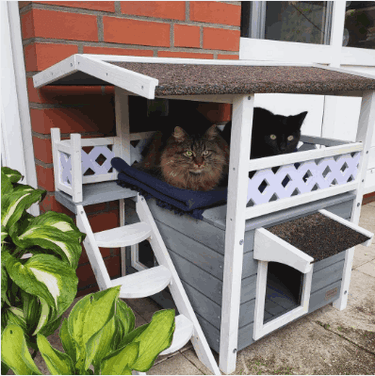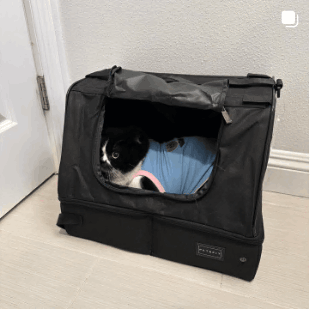FAQ ABOUT SOFT CRATE
Certainly! Here are some frequently asked questions (FAQs) about soft crates:
-
Are soft crates good for dogs? Soft crates can be suitable for some dogs, especially those who are already crate-trained and are comfortable with the softer, more enclosed environment. They're lightweight, easy to transport, and often collapsible, making them convenient for travel. However, they may not be ideal for dogs who are prone to chewing or have anxiety issues, as they are less sturdy and may not provide as much security.
-
What's the difference between a kennel and a crate? In general terms, a kennel refers to a larger enclosure where a dog can move around more freely, while a crate is a smaller, more confined space often used for training or confinement purposes. Kennels are commonly found outdoors and can be used for housing multiple dogs, while crates are typically used indoors and are meant for individual dogs.
-
What is the purpose of a crate? The primary purpose of a crate is to provide a safe and secure space for a dog, whether for transportation, training, or temporary confinement. Crates can aid in house training, prevent destructive behavior, and provide a retreat for the dog to relax and feel secure.
-
How do you make a comfortable crate? To make a crate comfortable for a dog, you can add soft bedding, toys, and familiar scents. Ensure the crate is appropriately sized so that the dog can stand, turn around, and lie down comfortably. It's also essential to place the crate in a quiet, low-traffic area of the home to minimize disturbances.
-
Can I crate my dog for 12 hours? Crating a dog for 12 hours straight is not recommended and can be harmful to the dog's physical and mental well-being. Dogs need regular breaks for exercise, mental stimulation, and bathroom breaks. If you need to leave your dog for an extended period, consider hiring a pet sitter or using a doggy daycare facility instead of crating for such a long duration.
-
Are dogs OK in crates overnight? Many dogs are comfortable sleeping in crates overnight, especially if they have been properly introduced to the crate and have positive associations with it. However, it's essential to ensure the crate is appropriately sized, comfortable, and located in a quiet area to promote restful sleep.
-
Is it good or bad to crate a dog? Crating a dog can be beneficial when done responsibly and humanely. It provides a safe and secure space for the dog, aids in house training, prevents destructive behavior, and can offer comfort and security to the dog. However, it's crucial to avoid excessive or prolonged crating and to ensure the dog has ample opportunities for exercise, socialization, and mental stimulation.
-
Is a crate or cage better for a puppy? Both crates and cages can be suitable for puppies, depending on their individual needs and the specific situation. Crates are typically more enclosed and provide a cozier environment, which some puppies may prefer. Cages, on the other hand, offer more visibility and airflow, which can be advantageous for puppies who may feel anxious or claustrophobic in a crate.
-
Should you always use a dog crate? Whether or not to use a dog crate depends on various factors, including the dog's temperament, training needs, and lifestyle. Crates can be a valuable tool for some dogs, especially during house training or when traveling. However, they are not suitable for every dog, and alternative methods of confinement and training should be considered as well.
-
Is it cruel to leave a dog in a crate all day? Leaving a dog in a crate all day can be considered cruel, as it deprives the dog of necessary exercise, mental stimulation, and social interaction. Dogs are social animals and thrive on companionship and activity. Prolonged confinement in a crate can lead to boredom, anxiety, and even physical health issues.
-
Do dogs prefer open or closed crates? Some dogs may prefer open crates because they offer better visibility and airflow, allowing the dog to feel less confined. However, other dogs may feel more secure in closed crates, which provide a den-like environment and can help them feel safe and protected.
-
Are dogs happier sleeping in a crate? Whether or not a dog is happier sleeping in a crate depends on the individual dog and its experiences with crate training. Some dogs may find comfort and security in sleeping in a crate, while others may prefer sleeping in a bed or other open space. It's essential to observe your dog's behavior and preferences to determine what sleeping arrangement makes them happiest.
-
Is it best to let the puppy cry in the crate? It's generally not recommended to let a puppy cry excessively in the crate, as this can lead to stress and anxiety. Instead, gradually acclimate the puppy to the crate through positive reinforcement and short periods of confinement, gradually increasing the duration over time. Providing comfort items and engaging in crate training exercises can also help alleviate the puppy's distress.
-
At what age should you stop using a puppy crate? The age at which you stop using a puppy crate depends on the individual dog and its maturity level. Some dogs may outgrow the need for a crate as they become more reliable with house training and develop better impulse control, while others may continue to benefit from crate use throughout their lives, especially during times of stress or change.
-
How many months should you crate a puppy? The duration of crate training for a puppy can vary depending on factors such as the dog's breed, temperament, and individual needs. In general, crate training may continue for several months until the puppy is reliably house-trained and can be trusted to be left alone without causing damage or getting into trouble.
-
Is it cruel to put a dog in a crate? Crating a dog is not inherently cruel when done responsibly and humanely. Crates can provide a safe and secure space for dogs, especially during times of stress, training, or when traveling. However, it's essential to avoid excessive or prolonged crating and to ensure the dog's needs for exercise, mental stimulation, and social interaction are being met.
-
Are soft crates suitable for all dogs? Soft crates are generally suitable for smaller to medium-sized dogs, but larger and more energetic dogs may require a sturdier crate. Additionally, dogs who are prone to chewing or have anxiety issues may not be well-suited for soft crates.
-
How do I clean a soft crate? Most soft crates come with removable and washable fabric covers. Simply unzip or remove the cover and launder it according to the manufacturer's instructions. The frame of the crate can usually be wiped down with a damp cloth.
-
Can I use a soft crate for travel? Yes, many soft crates are designed specifically for travel and are lightweight and collapsible for easy transport. However, it's essential to ensure that the crate is airline-approved if you plan to use it for air travel.
-
Are soft crates as durable as wire or plastic crates? Soft crates are typically not as durable as wire or plastic crates, as they are made from fabric materials. While they can withstand normal use, they may not hold up as well to chewing or scratching.
-
How do I choose the right size soft crate for my dog? To choose the right size soft crate, measure your dog from the tip of their nose to the base of their tail for length, and from the top of their head to the ground for height. Add a few inches to each measurement to ensure your dog has enough room to stand up, turn around, and lie down comfortably.
-
Can I use a soft crate for crate training my puppy? Yes, soft crates can be used for crate training puppies, but it's essential to supervise them closely to prevent chewing or accidents. Gradually acclimate your puppy to the crate using positive reinforcement techniques, and never leave them crated for extended periods without breaks.
-
Are soft crates safe for dogs? Soft crates can be safe for dogs when used correctly and with supervision. It's essential to ensure that the crate is securely assembled and that your dog cannot escape or injure themselves on any sharp edges or protruding parts.
-
Can I leave my dog unattended in a soft crate? While many dogs can be left unattended in a soft crate for short periods, it's generally not recommended for extended periods or for dogs prone to anxiety or escape attempts. Always monitor your dog's behavior when crated and provide regular breaks for exercise and bathroom breaks.
-
Are soft crates easy to set up and take down? Yes, most soft crates are designed to be easy to set up and collapse for storage or travel. They typically feature a collapsible frame that can be assembled or disassembled quickly and without the need for tools.
-
Can I use a soft crate outdoors? Soft crates are generally intended for indoor use, as they may not provide adequate protection from the elements or withstand exposure to rain, wind, or sun. If you need a crate for outdoor use, consider using a more durable option such as a wire or plastic crate.








